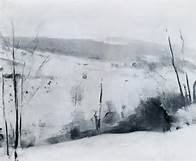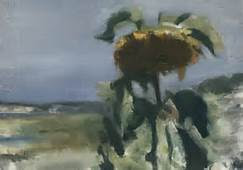Where we are currently in the cultural history of ideas is
hard to pin down. Ex post facto is always easier. The past has already been
packaged and defined by countless historians but the present as it evolves into
the future is hard to fix and if we try to paste the past on the present
we get into a lot of trouble. It seems to work momentarily like assuming Trump
is Hitler or the removal of a statue of Columbus from a college campus is akin
to the destruction of a Buddhist statue by the Taliban. But is the past really so well categorized and no longer open
for discussion. This struck me when I wrote about a visit I made to Edwin Dickinson on Cape Cod in 1970. After I had seen his work at the Biennale in
Venice in 1968, I found myself encouraged by his love of the observed world to
persevere in my pursuit of realism in the context of the overwhelming dominance
of High Modernism in mid-century America. However, in my more recent analysis
of his work I noticed that his phenotype was more 19th century than
20thc and from the perspective of where we stand now seemed to float further
and further into the past like some flotsam and jetsam thrown into the wake of
a steamship until it is irretrievable and disappears out of sight. And I would
add that if such a person were to live in our day and age he or she would be so
out of sync with the prevailing
zeitgeist they would most likely go insane.
 |
| Dickinson |
The most salient characteristic of Dickinson is artist as
observer. Not an observer who looks coldly at the world but one who seeks to be
at one with what he sees. He takes an anti-solipsistic stance where like
Stevens in his great poem “Idea of order at Key West” Dickinson interweaves the
self and nature. And most importantly Dickinson’s persona yearns for a meaning
to one’s life on earth, a romantic ache for for a meaningful story on the world's stage. It has a strong narrative bent where he is an
actor in his own play. Not Beckett but Shakespeare with a beginning, middle and
denouement. I have talked elsewhere of the deconstruction of the strong self at
the hands of the deconstructionists or the supremacy of things a la Duchamp or
the cosmic melding of self and society from Hegel where we are always mediated
by being part of society. This is where we are currently in our world of art, a
place where in in an essay on Jed Perl’s criticism I expressed the idea that we have
been turning around in circles for quite some time. At the end of history there
are no more mysterious unknowns ahead of us to conquer. We are surrounded by
all the detritus of society that is circling around an immense black hole. As
it circles around we are totally unaware that is slowly sinking into the abyss.
Recently, I sent out images of my new work to several names on my
email list. A few thoughtful replies
came back acknowledging that the color of the new work was richer and more
evocative. An unexpected reply came from Lorraine Shemesh whom I met , when we
both studied at the BU Summer program in Tanglewood, Massachusetts in 1969.
Phillip Pearlstein was the artist in residence and several well-known New
Realists came to visit most notably Al Leslie. There was a lot written about
the New Realists in the art press at the time, which peaked with a cover story
in Newsweek in 1970 featuring a painting by Bill Bailey on the cover. Two years
later he would be my senior project advisor at Yale. Another fellow student at
Tanglewood, Paul Dinger arranged a visit to Leslie’s studio in NYC after the
program ended for an article in the art magazine “Boston Review of the
Arts”, that he had recently founded.
Probably for the only time in my life I felt as an artist part of a movement.
 |
| Shemesh |
Shemesh shows at the Allan Stone gallery in New York. Judging
from the images in the two catalogs she sent me, she is clearly well trained in
the tradition of classical painting as it was taught at BU where she got her BFA
in 1971. The first catalog is a retrospective of her work, which culminates
around 2009 with her iconic pool paintings that have evolved from swimmers at
the surface or just below to a view of their now faceless bodies and body parts
totally submerged. Whereas the earlier painting retained the notion of an
observation of swimmers in a recognizable setting, the latest work puts the observer in with the
observed. She does not rely on a romantic search for connections between
herself and the environment that allows Dickinson to overcome his solipsistic
isolation but conveys rather the inability to jettison the self in such a
liquid realm. Of course to swim casually in a non-competitive manner implies the
desire of the swimmer to enjoy being buoyed up by a warm and caressing world
similar to the amniotic fluid that supports a fetus. Shemesh retains a strange, almost awkward, disconnect between the possibility of a merger between the water and the physical
hardness of the body that resists it. There is built into her work the impossibility of
the kind of cosmic explosion of the self of a Pollack or the a priori
connection one finds in Dickinson or for that matter the poems of Walt Whitman. I think that this is inherited from her realist background but also from the edgy postmodernist
zeitgeist of the New York scene. I find myself using the word impossible again as I did in
the essay on the play at BAM on Thomas Merton that stated unambiguously the
impossibility of transcendence in a world awash in physical drives and
passions. Or the word incommensurable to express the distance of paint and meaning when I wrote
about a show I had with Paul Pollaro at the Bromfield Gallery in Boston.
 |
| Shemesh |




